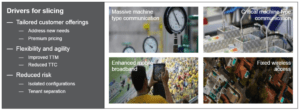Twitter Feed
SourceConnecte! Marketplace With A Mission
Earlier this year, GC GlobalNet launched a new breed of B2B e-commerce sites. Curated by Kevin L. Jackson, SourceConnecte (with an “eâ€) went live with three strategic goals in mind: Efficiently leverage modern…
Potential vs. Reality: Is Edge Computing Real?
Edge computing provides compute, storage, and networking resources close to devices generating traffic. Its benefits are based on an ability to provide new services capable of meeting stringent operational requirements…
Enabling Digital Transformation
Digital transformation integrates technology into all areas of an organization’s business or mission. Its fundamental purpose is to create and deliver innovative and industry-changing products and services to a global…
The ThinkShield Story Part 1: The Challenge
The cybersecurity challenge seems to be growing daily. Threats are becoming more sophisticated, and attacks are becoming more destructive while the corporate world’s response seems to resemble a deer…
CIO dream team: Who’s in and why?
Today’s CIO navigates the twin challenges of enabling new business models and managing rapid technological change. Cloud computing strategies are now table stakes. CIOs must make complex decisions about using…
Digital Transformation and the Mainframe
Digital transformation infuses digital technology into all areas of an organization’s business or mission. Its fundamental purpose is to create and deliver innovative and industry-changing digital products and services to…
Composable Architecture Q&A. Are you ready?
Q: Is it time for my company to jump on the composable architecture bandwagon? A: Composable architectures are quickly becoming essential to the modern enterprise. Citing a recent Forrester study:…
Increase Productivity by Reducing Technology Distraction: Lessons from Forrester Research
Workplace productivity is hurt every day by the very technology developed and purchased to improve it. Forrester announced this surprising conclusion in their latest “How To Wake Up From The Nightmare…
Unveiling the end-to-end capabilities for the networked society
An Interview with Henrik Basilier By Kevin L. Jackson The telecom industry is rapidly moving towards a future in which networks must have the capabilities of delivering services with the…
AT&T Finance Solutions GM on Shrimping, Software, and CX
Helping clients address the trends and challenges presented by the Financial Services industry is the main focus for René Dufrene in his role as General Manager of Finance Solutions at…
Digital transformation necessitates changes in an organization’s operational processes. According to Harvard, a focus on operations can lead to business process optimization and entirely new revenue streams. Three common routes for this are the following:
- Robotic process automation (RPA) which uses artificial intelligence to automate routine activities
- Remote worker enablement that uses workspace virtualization and advanced visualization technologies
- Performance management decision making based on real-time data that delivers deeper insights into customers, products, and operational regions
An important component of operational change is gaining a better understanding of your end customer. By observing and recording the digital footprint of consumers, information can be accumulated on customers, processes, organizations, and devices.
Since customers and businesses are increasingly active and identifiable online, organizations can operationally leverage digital marketing tools to personalize their product and service promotions, with the goal of increasing customer loyalty.
Digitize Products and Services
Organizations today increasingly realize they can no longer focus on just selling products; they need to sell an experience.
Advanced digital technology, powered by a Social, Mobile, Analytics and Cloud (SMAC Stack) that is informed by sensors, can improve business processes in several ways.
For example, big data analytics can help inbound logistics run more smoothly by tracking product movements; the cloud can be used to create uniform business processing platforms; and mobile platforms can enable employees to perform their work anytime, anywhere, on any device.
With value chains increasingly integrated among businesses, organizations can become part of a larger ecosystem, enabling them to offer end-to-end services to their customers.
Organizations can either shape and orchestrate an ecosystem themselves and provide a significant number of products and services, or focus on a niche service that adds value to the customer experience and becomes part of an already existing ecosystem.
Collaboration Is Key
Digital collaboration today stretches beyond the borders of the organization, with communities co-creating products or services, and customers providing opinions and suggestions for product improvements through online forums.
Organizations operate with a familiar legacy perspective of customers, processes, metrics, business models, and technology, believing that it remains the solution to digital relevance. Individual groups recognize the strength in collaboration as their research, work, and shared insights contribute to new strategic road maps that plan for digital transformation ownership, efforts, and investments.
A dedicated digital transformation team forms to guide strategy and operations based on business and customer-centric goals. The new infrastructure of the organization takes shape as roles, expertise, models, processes, and systems to support transformation are solidified.
According to the research, understanding the six stages of digital transformation maturity will lead to the following business benefits:
- Customization of the maturity model to inform specific road map development
- Peer company benchmarking
- Executive alignment and buy-in
- Bolster sense of urgency
- Future marketing trend insights
- Prioritize digital transformation initiatives
- Set a new vision, course, and platform for leadership
- Develop new models, processes, and a purpose for technology and the future of work
Organizations should adopt and use one of the many digital transformation frameworks to manage the process of creating a digital business strategy.
Read more about digital transformation and transformation frameworks: grab a copy of my new book, Click to Transform!
Cloud Computing
- CPUcoin Expands CPU/GPU Power Sharing with Cudo Ventures Enterprise Network Partnership
- CPUcoin Expands CPU/GPU Power Sharing with Cudo Ventures Enterprise Network Partnership
- Route1 Announces Q2 2019 Financial Results
- CPUcoin Expands CPU/GPU Power Sharing with Cudo Ventures Enterprise Network Partnership
- ChannelAdvisor to Present at the D.A. Davidson 18th Annual Technology Conference
Cybersecurity
- Route1 Announces Q2 2019 Financial Results
- FIRST US BANCSHARES, INC. DECLARES CASH DIVIDEND
- Business Continuity Management Planning Solution Market is Expected to Grow ~ US$ 1.6 Bn by the end of 2029 - PMR
- Atos delivers Quantum-Learning-as-a-Service to Xofia to enable artificial intelligence solutions
- New Ares IoT Botnet discovered on Android OS based Set-Top Boxes










